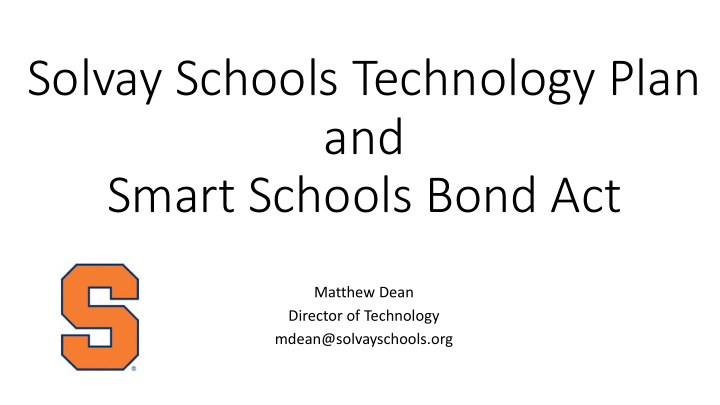



Solvay Schools Technology Plan and Smart Schools Bond Act Matthew Dean Director of Technology mdean@solvayschools.org
Uses for the SSBA
Current Network Configuration SES SMS SHS Three Wiring Closets Six Wiring Closets Seven Wiring Closets • 5 (48-Port) 1GB • 12 (24/48-Port) 1GB • 14 48-Port 10GB Switches Switches Switches • 10 Older Wireless APs • 40 Wireless APs (Cloud • 8 (24/48-Port) 1GB Controlled) Switches • Cramped Space • District’s Core • Phone & Data Center • 27 Older Wireless APs
SMS Wireless Access Points
Current Asset Inventory • 673 Windows Desktops • Classrooms, Offices, Labs • 157 Laptops (Mac/PC) • Carts, Classrooms, Labs, Staff Assigned • 638 Chromebooks • Carts, 6 th Grade Classrooms, Staff Assigned • 441 Apple iPads • Carts, Staff Assigned
6 th Grade 1:1 Chromebook Pilot • Robust Wi-Fi enables ease of access • Having the Chromebooks right in the classroom saves time tracking down shared carts or getting a class to a computer lab etc. • CNYRIC Bandwidth increased from 20Mbps -> 100Mbps • This has eliminated a lot of the buffering or slowdowns we have seen in previous years.
Infrastructure Upgrades Recommendations • Would like to upgrade all remaining 1GB switches to 10GB switches across the network. This will future proof us for at least the next 5 years. • Would need to upgrade the wireless at SES and SHS to match what the SMS currently runs. Meraki Wireless is a robust cloud-based controller-less solution that has been working great at the middle school for almost a year. • Total cost to upgrade network switches and wireless ~ $200,000
1:1 Chromebook to Student Plan • Phased in multiyear approach to bring students and staff up to speed. • Leveraging Google Classroom • Professional Development for staff • CNYRIC ITD and local trainers • Prepare students for Computer Based Testing CBT (starting this Spring @ Elementary school)
International Society for Technology in Education (ISTE ) Standards 1. Creativity and innovation 2. Communication and collaboration Students use digital media and environments to communicate and • Students demonstrate creative thinking, construct work collaboratively, including at a distance, to support knowledge, and develop innovative products and individual learning and contribute to the learning of processes using technology. others. a. Apply existing knowledge to generate new a. Interact, collaborate, and publish with peers, ideas, products, or processes experts, or others employing a variety of digital b. Create original works as a means of personal or environments and media group expression b. Communicate information and ideas effectively c. Use models and simulations to explore complex to multiple audiences using a variety of media and systems and issues formats d. Identify trends and forecast possibilities c. Develop cultural understanding and global awareness by engaging with learners of other cultures d. Contribute to project teams to produce original works or solve problems
ISTE Standard For Students 3&4 3. Research and information fluency 4. Critical thinking, problem solving, and decision making • Students apply digital tools to gather, evaluate, and • Students use critical thinking skills to plan and use information. conduct research, manage projects, solve problems, a. Plan strategies to guide inquiry and make informed decisions using appropriate b. Locate, organize, analyze, evaluate, synthesize, digital tools and resources. and ethically use information from a variety of a. Identify and define authentic problems and sources and media significant questions for investigation c. Evaluate and select information sources and b. Plan and manage activities to develop a digital tools based on the appropriateness to solution or complete a project specific tasks c. Collect and analyze data to identify solutions d. Process data and report results and/or make informed decisions d. Use multiple processes and diverse perspectives to explore alternative solutions
ISTE Standard For Students 5&6 5. Digital citizenship 6. Technology operations and concepts • Students understand human, cultural, and societal • Students demonstrate a sound understanding of issues related to technology and practice legal and technology concepts, systems, and operations. ethical behavior. a. Understand and use technology systems a. Advocate and practice safe, legal, and b. Select and use applications effectively and responsible use of information and technology productively b. Exhibit a positive attitude toward using c. Troubleshoot systems and applications technology that supports collaboration, learning, d. Transfer current knowledge to learning of new and productivity technologies c. Demonstrate personal responsibility for lifelong learning d. Exhibit leadership for digital citizenship
One-to-One Replacement Plan School Year 3 4 5 6 7 8 9 10 11 12 Inventory Purchased $250/Chrombook 2016-2017 110 120 120 120 130 130 130 860 370 $92,500.00 2017-2018 110 120 120 120 120 120 130 130 130 130 1230 370 $92,500.00 2018-2019 110 120 120 120 120 120 130 130 130 130 1230 490 $122,500.00 2019-2020 110 120 120 120 120 120 130 130 130 130 1230 370 $92,500.00 2020-2021 110 120 120 120 120 120 130 130 130 130 1230 370 $92,500.00 2021-2022 110 120 120 120 120 120 130 130 130 130 1230 490 $122,500.00 2022-2023 110 120 120 120 120 120 130 130 130 130 1230 370 $92,500.00 2023-2024 110 120 120 120 120 120 130 130 130 130 1230 370 $92,500.00 2024-2025 110 120 120 120 120 120 130 130 130 130 1230 490 $122,500.00 2025-2026 110 120 120 120 120 120 130 130 130 130 1230 370 $92,500.00 Approx Enrollment 110 110 110 110 110 110 130 130 130 130 1180 $1,015,000.00 Purchase New Smart Schools Bond Money $1,132,000 Local Funds
Questions ??
Recommend
More recommend